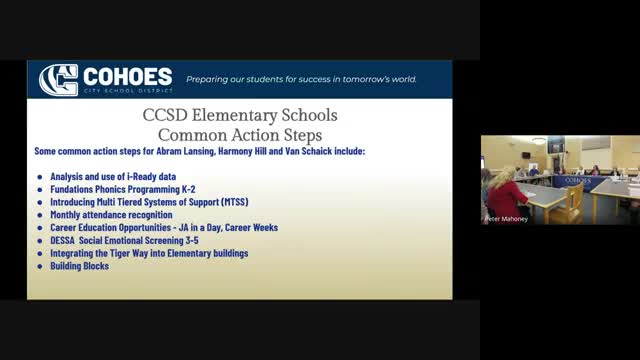Cohoes elementary schools outline goals on literacy, attendance and behavioral supports
October 23, 2025 | COHOES CITY SCHOOL DISTRICT, School Districts, New York
This article was created by AI summarizing key points discussed. AI makes mistakes, so for full details and context, please refer to the video of the full meeting. Please report any errors so we can fix them. Report an error »

Cohoes City School District elementary building leadership teams presented coordinated goals on literacy growth, student behavior and chronic absenteeism at the Oct. 22 board meeting.
School leaders said they are using I-Ready diagnostic data more consistently and expanding multi-tiered systems of support (MTSS) across buildings to identify students who need intervention earlier. Dr. Mundell, who opened the presentations for absent administrators, said the district is "pinch hitting" while staff transitions continue and thanked board members for their service.
Harmony Hill reported using foundation phonics for K–2 classrooms, piloting additional Tier 1 literacy programs in upper grades and regular data review with a BOCES coach. Harmony Hill’s team also highlighted social-emotional screening (DESSA), a “Tiger Way” PBIS poster system and a new Tiger Cove Courier to encourage authentic student writing.
Lansing described a shift back to traditional small reading groups, the creation of building MTSS teams (data team and student-support team) and greater vertical alignment so grade bands share instructional language and scaffolds. Lansing said it is piloting trauma‑skilled supports and planning teacher rounds for peer observation.
VanSkeit (presenting as the third elementary team) summarized strategies it calls "purposeful practices" from trauma‑skilled schools training to reduce classroom disruptions, add short movement breaks, and expand calming corners and reset rooms. VanSkeit noted the reset room is staffed and used for scheduled short breaks, sensory supports and academic re-engagement, and leaders plan site visits to neighboring districts to study models and staffing ratios.
All three buildings named attendance reduction among top goals. Reported measures include daily monitoring, monthly grade-level attendance incentives, family outreach (phone and ParentSquare messaging), student-led videos to remind families of start times and trimester prizes for parents when student attendance meets targets. Several buildings reported recent declines in chronic absenteeism but said percentages remain above targets and they expect to continue weekly monitoring and tiered interventions.
Leaders also described career‑exploration activities (Junior Achievement in a Day, trade days, and visits from local engineers) and family engagement events such as Halloween bingo nights and breakfast invitations.
Board members praised the presentations and encouraged teams to continue peer visits and to treat these plans as evolving documents that will be adjusted with state guidance and ongoing data.
School leaders said they are using I-Ready diagnostic data more consistently and expanding multi-tiered systems of support (MTSS) across buildings to identify students who need intervention earlier. Dr. Mundell, who opened the presentations for absent administrators, said the district is "pinch hitting" while staff transitions continue and thanked board members for their service.
Harmony Hill reported using foundation phonics for K–2 classrooms, piloting additional Tier 1 literacy programs in upper grades and regular data review with a BOCES coach. Harmony Hill’s team also highlighted social-emotional screening (DESSA), a “Tiger Way” PBIS poster system and a new Tiger Cove Courier to encourage authentic student writing.
Lansing described a shift back to traditional small reading groups, the creation of building MTSS teams (data team and student-support team) and greater vertical alignment so grade bands share instructional language and scaffolds. Lansing said it is piloting trauma‑skilled supports and planning teacher rounds for peer observation.
VanSkeit (presenting as the third elementary team) summarized strategies it calls "purposeful practices" from trauma‑skilled schools training to reduce classroom disruptions, add short movement breaks, and expand calming corners and reset rooms. VanSkeit noted the reset room is staffed and used for scheduled short breaks, sensory supports and academic re-engagement, and leaders plan site visits to neighboring districts to study models and staffing ratios.
All three buildings named attendance reduction among top goals. Reported measures include daily monitoring, monthly grade-level attendance incentives, family outreach (phone and ParentSquare messaging), student-led videos to remind families of start times and trimester prizes for parents when student attendance meets targets. Several buildings reported recent declines in chronic absenteeism but said percentages remain above targets and they expect to continue weekly monitoring and tiered interventions.
Leaders also described career‑exploration activities (Junior Achievement in a Day, trade days, and visits from local engineers) and family engagement events such as Halloween bingo nights and breakfast invitations.
Board members praised the presentations and encouraged teams to continue peer visits and to treat these plans as evolving documents that will be adjusted with state guidance and ongoing data.
View full meeting
This article is based on a recent meeting—watch the full video and explore the complete transcript for deeper insights into the discussion.
View full meeting
